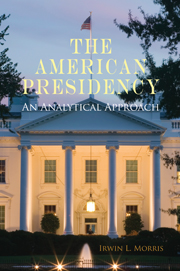Book contents
- Frontmatter
- Contents
- 1 Introduction
- 2 Science and the Study of the Presidency
- 3 The Presidency: Background and Foundations
- 4 Theories of Presidential Power
- 5 Electing a President
- 6 Congress and the President
- 7 The Supreme Court and the President
- 8 The President and the Executive Branch
- 9 The President and Foreign Policy Making
- 10 The President and Economic Policy Making
- 11 Presidential Greatness
- Bibliography
- Index
8 - The President and the Executive Branch
Published online by Cambridge University Press: 05 June 2012
- Frontmatter
- Contents
- 1 Introduction
- 2 Science and the Study of the Presidency
- 3 The Presidency: Background and Foundations
- 4 Theories of Presidential Power
- 5 Electing a President
- 6 Congress and the President
- 7 The Supreme Court and the President
- 8 The President and the Executive Branch
- 9 The President and Foreign Policy Making
- 10 The President and Economic Policy Making
- 11 Presidential Greatness
- Bibliography
- Index
Summary
The rise of a professionalized bureaucracy and the concomitant growth of the American administrative state are arguably the most significant institutional developments at the national level since the Civil War. This is not to say that the legislative branch and the judicial branch have not evolved over the course of nearly 150 years, but the term “evolution” simply does not do justice to the dramatic transformation of the executive branch over this time period. The broad outlines of this transformation – in magnitude and content – are described in the section on the executive branch in Chapter 3.
In this chapter, we focus specifically on the president's relationship with the agencies and bureaucracies in the executive branch and the scholarship that examines this relationship. A quick review of this scholarship provides us, immediately, with an interesting and important puzzle relating to the ability of the president to effectively manage the executive branch. Simply put, there is a puzzling lack of consistency in scholarly accounts of the president's relationship with the executive bureaucracy. Some scholars focus on the president's domineering control over the bureaucracy. Other research suggests that the executive branch is structurally uncontrollable. An additional strain of research focuses on the legislative control of federal agencies. We will examine these inconsistencies and consider possible explanations for them. Then you will have an opportunity to examine one particular manifestation of the president's relationship with the executive branch – the president's influence over the policy-making activities of the Federal Open Market Committee (FOMC), an important policy-making committee within the Federal Reserve System.
- Type
- Chapter
- Information
- The American PresidencyAn Analytical Approach, pp. 190 - 203Publisher: Cambridge University PressPrint publication year: 2010



